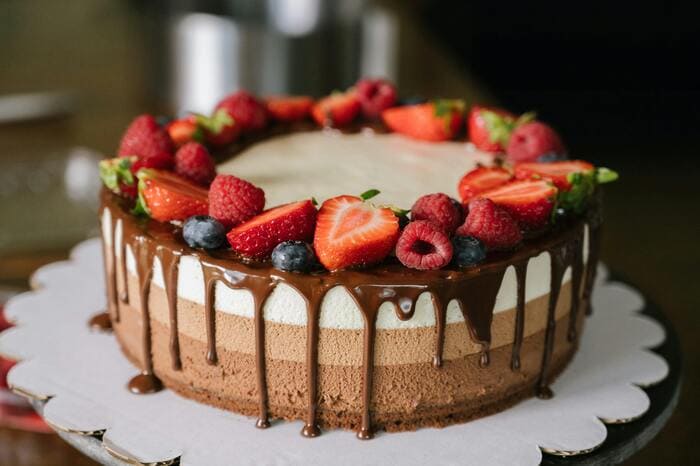Decorating a cake is more than just adding a finishing touch — it’s a way to express creativity, enhance flavor, and elevate your baking from simple to stunning. While sugar flowers and fondant toppers are popular options, edible decorations made from natural ingredients like fruits, nuts, and flowers are gaining more and more popularity for their beauty, texture, and flavor. In this guide, we’ll explore the art of decorating cakes with edible elements, how to prepare them safely, and the best combinations to complement your creations.
Why Choose Edible Natural Decorations?
Natural elements bring authenticity and elegance to cake decoration. Unlike artificial toppers or plastic decor, edible garnishes add visual appeal while enhancing the flavor experience. They’re perfect for rustic, minimalist, elegant, or garden-inspired designs — and they’re often more eco-friendly and accessible too.
Common Benefits:
- Add color, texture, and freshness
- Elevate the cake’s aroma and taste
- Make cakes more appealing in photos (great for social media)
- Perfect for themed occasions: weddings, birthdays, spring or holiday cakes
- Encourage sustainable and clean baking practices
Fruits: Colorful, Juicy, and Vibrant
Fresh fruit is one of the most versatile cake toppers. It offers bold colors, natural sweetness, and a fresh visual element.
Best Fruits for Decorating:
- Berries (strawberries, raspberries, blueberries, blackberries)
- Figs (fresh or dried)
- Citrus slices (oranges, blood oranges, lemons)
- Pomegranate seeds
- Grapes (cut in halves or clusters)
- Apples or pears (sliced and dried)
- Passionfruit halves
- Cherries with stems
Tips for Using Fruits:
- Wash and dry fruits thoroughly
- Choose firm, ripe fruit to avoid leaking juices
- Add fruits just before serving to preserve freshness
- Brush sliced fruits with lemon juice to prevent browning
- Consider dipping or glazing in sugar syrup for shine and preservation
Fruit is especially stunning on naked cakes, semi-naked cakes, and drip cakes (see article #34). You can also combine fruit with herbs for a fresh, organic feel.
Nuts: Crunch, Contrast, and Sophistication
Nuts add a rustic, gourmet look and give your cake an extra layer of texture and taste.
Common Edible Nuts for Decoration:
- Almonds (whole, slivered, or toasted)
- Pecans or walnuts (great on carrot or spice cakes)
- Hazelnuts
- Pistachios (chopped or ground for color contrast)
- Macadamia or cashew for tropical themes
How to Use Them:
- Toast lightly to enhance flavor and crunch
- Press onto the sides or top of frosted cakes
- Combine with caramel or chocolate for clusters
- Create nut borders or sprinkle over piped buttercream designs
For best results, apply nuts right after frosting while the surface is still tacky.
Edible Flowers: Delicate, Natural, and Artistic
Edible flowers are a breathtaking way to decorate cakes for weddings, showers, and elegant gatherings. They add color, sophistication, and a romantic touch.
Popular Edible Flowers:
- Pansies and violas
- Marigolds
- Calendula
- Roses (petals only)
- Chamomile
- Lavender
- Cornflowers
- Nasturtiums
- Hibiscus
- Jasmine (edible varieties only)
Safety Note:
Always source your flowers from organic, pesticide-free sources. Never use florist flowers or flowers from unknown sources. Rinse gently and pat dry before using.
How to Use Flowers:
- Place whole blooms or petals on top of cakes or around the base
- Combine with buttercream swirls or drip decorations
- Crystallize with sugar for a sparkling effect
- Use flowers as a “crown” atop a layer cake
- Match colors to the event theme for a cohesive design
See article #37 (How to Store Frosted Cakes Without Ruining the Finish) for storage tips when using fresh flowers and fruit.
Other Edible Elements to Try
- Chocolate shards or curls: Easy to make and customizable
- Candied citrus peels or ginger: Bright, tangy and beautiful
- Herbs like rosemary, thyme or mint: Add fragrance and greenery
- Edible gold leaf or shimmer dust: Elegant luxury with minimal effort
- Dehydrated fruit slices: Add a rustic, artistic flair
Combining Elements Like a Pro
The magic happens when you mix these decorations strategically. Here are some stunning combos:
- Rustic autumn cake: Toasted pecans + dried orange slices + cinnamon sticks
- Spring garden cake: Edible flowers + strawberries + mint leaves
- Elegant wedding cake: White roses + gold leaf + fresh figs
- Tropical cake: Pineapple slices + passionfruit + toasted coconut + edible flowers
- Chocolate lover’s cake: Ganache drip + chocolate curls + hazelnuts + cherries
Always consider color balance, height variation, and placement. Use odd numbers and asymmetry to create natural-looking arrangements.
Practical Tips for Success
- Decorate as close to serving time as possible for freshness
- Refrigerate cakes with fresh elements in a box or under a dome
- Avoid placing decorations on warm frosting
- Use toothpicks or skewers (hidden) for structure if needed
- Test unknown edible items before using on large cakes
Sourcing Edible Decorations
You can find edible flowers, herbs, and specialty fruits at:
- Farmer’s markets
- Organic grocery stores
- Specialty baking suppliers
- Your own herb or flower garden (with care!)
Final Thoughts
Edible decorations turn a simple cake into a work of edible art. With fruits, nuts, flowers, and more, you don’t need complicated tools or techniques to create something stunning. The beauty lies in the balance of nature and design — a celebration of flavor, texture, and aesthetics.
In the next article (#39), we’ll look at “Common Cake Decorating Mistakes and How to Fix Them” — an essential guide to help you avoid the most frequent mishaps and recover like a pro.
